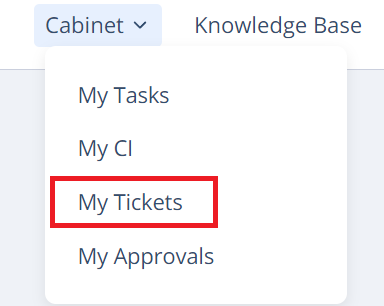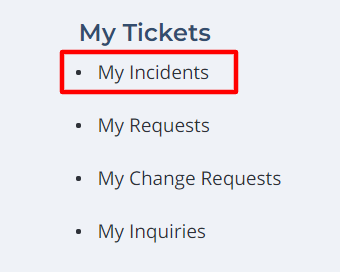- via the agent interface
- via the Self-Service Portal
- by converting a user query into an incident.
Create an end-user Incident via the agent interface
To create an incident, complete the steps below:
- Navigate to Incident Management → New.
- Fill in the fields.
- Click Save or Save and Exit to apply the changes.
You can copy the record number, title and link via the hamburger menu. To do this, click Generate link.
New Incident form fields
| Field | Mandatory | Description |
|---|---|---|
| Number | Y | Incident number. This field has the INCXXXXXXX format and is populated automatically. |
| Caller | Y | Specify the originator of the incident. The field is not displayed on the form if the Infrastructure incident checkbox is selected. |
| Company | N | Specify the company to which the incident is related. |
| Contact Type | Y | The source from which the request is received. Available options:
When a record is saved, the field is read-only. |
| Service | Y | Specify the service affected by the incident. |
| Related CIs | N | Specify the related configuration items affected by the incident. |
| Assignment Group | Y | Specify the group assigned to work on the incident. When an incident is assigned to a responsible group, the Assigned User field becomes non-mandatory for the states Registered and Assigned. There is a dependency between the Assigned User and Assignment Group fields. To learn more, refer to Restrictions for assignment.
|
| Assigned User | Y | Specify a responsible person to work on the incident. This field is mandatory for the states In Progress, Completed and Closed. When an incident is assigned to a user, the Assignment Group field becomes non-mandatory for the states Registered and Assigned. To reassign a user or a group, use the Reassign button at the top right corner of the window, or set a new assigned user, or a group by clicking the magnifier icon next to the Assigned User field. As a result, the incident state changes to Assigned. There is a dependency between the Assigned User and Assignment Group fields. To learn more, refer to Restrictions for assignment. Later, you can reassign the incident by changing the value of this field or clicking Reassign in the upper right corner. The state of the incident will automatically change to Assigned, unless it is already in this state. |
| Subject | Y | Add a brief description of the incident. After saving, the field is hidden from the form. |
| Description | N | Add a detailed description of the incident. |
| Steps to Reproduce | N | Specify the steps to reproduce the incident. |
| Screenshot | N | Upload screenshots supporting the incident, if any. |
| State | N | Specify the work state and progress of the incident. Available options:
See the Incident process article to learn more. |
| External Task | N | Specify the task to do for the external company. The field appears on the form when the state is External Processing. If the field is populated, it is displayed in other states. |
| External Company | N | Specify the company that works on the incident task externally. The field appears on the form when the state is External Processing. If the field is populated, it is displayed in other states. |
Impact | Y | Measure the impact caused by the incident on the business processes. Available options:
|
| Urgency | Y | Specify the urgency of the request. Typically, it is evaluated based on the time remaining until the incident impacts the business. Available options:
|
| Priority | Y | Identifies the importance of the incident. This field is populated automatically based on the value of the Impact and Urgency fields. Available options:
See the Priority Management article to learn more. |
| Attention Required | N | Select the checkbox to notify the line manager of the assigned group or user. |
| Major Incident | N | Select the checkbox to create a major incident. |
| Infrastructure Incident | N | Select the checkbox to create an infrastructure incident. When a record is saved, the field is read-only. |
| Followers List | N | Contains a list of users subscribed to receive notifications about this incident. This field is populated automatically. The field is read-only, and appears if at least one user follows the incident. |
Create an infrastructure incident
An infrastructure incident is an incident created by service agents of the 1st or the 2nd levels or by the integrated monitoring system.
Role required: ITSM_agent or admin.
To create an infrastructural incident, complete the steps described above, and select the checkbox Infrastructure Incident.
When Infrastructure Incident is selected, the choice list in the Contact Type field is changed:
- Monitoring
- 1st level
- 2nd level
In practice, incidents with the Contact Type set to Monitoring are created by an integrated monitoring system automatically.
Create a major incident
A major incident is an incident of the highest impact and highest urgency. It affects a large number of users, depriving them of vital business functions. Major incidents have a separate procedure with shorter time scales. Generally, major incidents require a large number of people of various hierarchy levels to be involved.
To create a major incident, complete the steps described above, and select the checkbox Major Incident.
After creating it, a new tab, Chronology, will be displayed next to the Related Records tab.
When the checkbox Major Incident is selected, the Impact field value changes to Very High.
Creating an end-user incident via the Self-Service Portal
To create an Incident, follow the steps below:
- Navigate to your Self-Service Portal main page.
- Click the Create Incident block and fill in the fields.
- Click Save.
New Incident form fields
| Field | Mandatory | Description |
|---|---|---|
| Urgency | Y | Specify the urgency of the request. Typically, it is evaluated based on the time remaining until the incident impacts the business. Available options:
|
| Subject | Y | Add a brief description of the incident. |
| Description | N | Add a detailed description of the incident. |
You can track the work process on the My Tickets page. To open the record of the incident, complete the following steps:
- In the header, navigate to Cabinet → My Tickets.

- Click My Incidents on the left.

- Check the state of the created incident.

Also, you can see more information about the incident by clicking the number.
User query to Incident transformation
Role required: incident_manager.
A user query is a higher-level entity than an incident. It can be converted into a request of another type, including type "incident." The conversion is available only through the agent interface.
- Navigate to User Queries → All User Queries.
- Open the user query you need to convert.
- Click the Incident button in the top-right corner of the form.

The button might be absent if the incident has already created from this user query. In this case, the incident and the user query are linked to each other:
- The reference to the incident is displayed in the The IncidentRelated Ticket field of the user query.
- The reference to the user query is displayed in the Related Records tab of the incident.